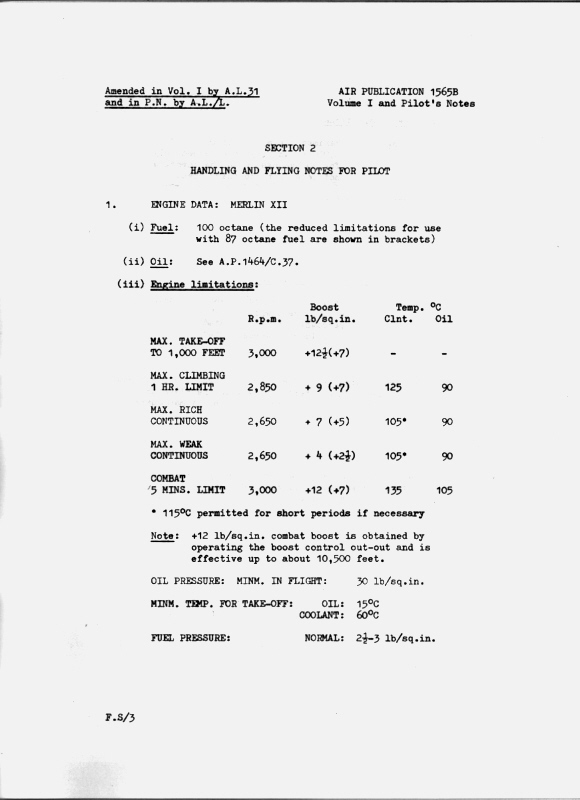
 |
|
#61
|
|||
|
|||
|
2270rpm is the minimum to prevent engine damage, 3000 was the proper setting.
|
|
#62
|
|||
|
|||
|
Ah thanks. I did not read minimum:
so for take-off they say: rpm in between 2270 and 3000 with max boost 12 boost either up to 1000 ft for extended time or up to 3 min. |
|
#63
|
|||
|
|||
|
Quote:
Hence the confusion. The manual itself does not describe any two different systems.
__________________
Il-2Bugtracker: Feature #200: Missing 100 octane subtypes of Bf 109E and Bf 110C http://www.il2bugtracker.com/issues/200 Il-2Bugtracker: Bug #415: Spitfire Mk I, Ia, and Mk II: Stability and Control http://www.il2bugtracker.com/issues/415 Kurfürst - Your resource site on Bf 109 performance! http://kurfurst.org 
|
|
#64
|
|||
|
|||
|
Quote:
This graph suggest (see boost falling) that +12 fell back to +9 within about 2500 feet. This would also suggest that using the boost cutout was quite useless above that altitude, since it gave you the same performance as not using it at all. http://www.spitfireperformance.com/p7280-speed.jpg Come to think of it, it seems to work exactly the same as the 109E's 1-minute rating, altough that latter was automated.
__________________
Il-2Bugtracker: Feature #200: Missing 100 octane subtypes of Bf 109E and Bf 110C http://www.il2bugtracker.com/issues/200 Il-2Bugtracker: Bug #415: Spitfire Mk I, Ia, and Mk II: Stability and Control http://www.il2bugtracker.com/issues/415 Kurfürst - Your resource site on Bf 109 performance! http://kurfurst.org 
|
|
#65
|
|||
|
|||
|
Quote:
|
|
#66
|
||||
|
||||
|
Quote:

Last edited by Kwiatek; 05-13-2012 at 11:09 AM. |
|
#67
|
|||
|
|||
|
Quote:
Use your imagination a bit where that little thing just above the "Push" sign goes when the red painted thumb lever is rotated back.
__________________
Il-2Bugtracker: Feature #200: Missing 100 octane subtypes of Bf 109E and Bf 110C http://www.il2bugtracker.com/issues/200 Il-2Bugtracker: Bug #415: Spitfire Mk I, Ia, and Mk II: Stability and Control http://www.il2bugtracker.com/issues/415 Kurfürst - Your resource site on Bf 109 performance! http://kurfurst.org 
Last edited by Kurfürst; 05-13-2012 at 11:17 AM. |
|
#68
|
|||
|
|||
|
Quote:
The "boost control cut-out" did not set a fixed throttle valve position. The position was directly controlled by the pilot but limited the opening of the valve that +12 boost was not exceeded. Thus when the throttle was fully forward (not in the gate position) the opening would increase with decreasing atmospheric pressure until it is fully open (at FTH). This is explained here: http://www.enginehistory.org/Piston/...erlinABC.shtml |
|
#69
|
|||
|
|||
|
Both positions of the red painted lever are shown in the drawing. I painted red lines into the drawing to show that the lever doesn't obstacle the gate position in any of the two positions.
|
|
#70
|
|||
|
|||
|
This graph shows that 12lbs boost would be available below about 15k feet, 2.5k feet below the full throttle altitude of 9lbs boost. That's how it works with outside pressure. And that's what being made possible with the abc cut out, see 41Sqn_Banks link.
|
 |
|
|